| Aircraft
of the Second World War at Sea
Part One: Germany
By Steve Cabral
March 2015
The Luftwaffe
The German Air Force was run as the private fiefdom of its
commander, Reichsmarschall Hermann Goring. In 1939 he had
the Kriegsmarine air units incorporated into his air force
and returned the pilots to the navy for re-assignment. In
revenge Admiral Raeder denied the Luftwaffe access to torpedoes
claiming they were naval weapons; Goring and his staff agreed.
The Luftwaffe had 132 torpedoes from 1939 through 1941. The
Italian Fiume F5W was used and a copy of a Norwegian torpedo
the F5B was eventually deployed. The navy and air force rarely
communicated and so the Luftwaffe, assuming anything at sea
was an enemy, frequently bombed Kriegsmarine ships in 1939
and 1940. The Channel Dash in 1942 illustrated how much could
be accomplished when the two services worked in unison.
Bases in conquered France and Norway proved to be perfect
for anti-shipping (A/S) operations. The primary A/S planes
were Ju-87, Do-17, Fw-200, Ju-88, He-111 (when fitted with
two torpedoes this plane was devastating), Do-217 and He-177.
The latter two were the usual platform for Hs-293 and Fritz
X A/S missiles though the Fw-200 and He-111 could also carry
them.
One of the main problems of German bombers was poor defensive
armament. Most had but 7.92 Machine guns with some 13mm and
20mm occasionally appearing especially late in the war.
Germany had a large number of recon aircraft; most were old
bombers like Ju-86’s or Do17’s while some were
dedicated like Fi-156, Fw-189 or Bv-141 - all of land-based.
At sea a flying boat was excellent at recon work, and Do-18
and Bv-138 flying boats and He-59 and Ar-196 floatplanes did
recon work for Germany as well as dedicated Air-Sea Rescue
(SAR) duties. The Do-18 and He-59 were quickly reassigned
though as they proved too vulnerable to air-air combat.
The Luftwaffe’s SAR was developed before the war and
He-59 were the first planes used along with some French captures
and Do-18’s. The first major rescue was on 18 December
1939 when a dozen Wellingtons were shot down near the navy’s
Heligoland anchorage and the He-59’s rescued about 20
men from them.
The Fighters
Almost no fighters were assigned to dedicated maritime duties.
However fighters escorted bombers assigned to such duties
flew combat air patrol near naval bases and escorted naval
missions on occasion in addition to normal operations. Fighters
also escorted SAR missions as the RAF considered SAR planes
fair game.
Bf-109

The Messerschmitt Bf-109 (aka Me-109) was the primary single-engined
fighter used by Germany in WW2. The Bf-109B saw service with
the Kondor Legion in Spain from 1937. When World War Two broke
out in 1939 the primary fighter was the Bf-109E with some
D models still in service. The E-3 featured 3 x 20mm cannons
and 2 x machine guns, and the E-4 (1940) had one 20mm removed.
The carrier-borne version Me-109Z was an E variant with larger
wings; they proved to be perfectly suited to short Scandinavian
runways when rebased there in 1941. In 1941 the Bf-109F was
introduced with a 15mm or 20mm cannon and two machine guns
as well as superior power and maneuverability. In 1942 the
Bf-109G was introduced with an armament of 1 x 20mm cannon
and two machine guns; the G-5 onward replaced the two machine
guns with 13mm cannon. The G-10 featured an upgrade to a 30mm
cannon in place of the 20mm. The ultimate in 1944 was the
109K with one 30mm and two 15mm cannons and a very powerful
engine. Messerschmitts were encountered on every front from
Norway to Egypt.
Bf-110
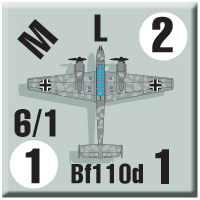
The twin-engine Messerschmitt was designed as a long-range
escort fighter in the late 1930’s all the major powers
had at least one. Though occasionally chopped up in the early
Blitzkriegs the Bf-110 generally gave good service. During
the Battle of Britain though the 110 failed against the R.A.F.
and began a change in use to fighter-bomber and night fighter.
It was in the latter role that the 110 excelled. At the outbreak
of war the majority of 110’s were C model with some
long-ranged D models. The 1941 E version was a fighter bomber
as was the 1942 F though the first 110 built as a night fighter
was also an F. The 1943 G had bomber destroyer versions and
night fighter versions. The C through F featured two 20mm
and four machine guns firing a heavy tight pattern as all
were mounted in the nose. The G version featured 2 x 30mm
and 2 x 20mm cannons and some variants. A rear gunner had
a single machine gun pointing rearward; a twin version was
eventually introduced. A new aircraft with larger glass cockpit
named Me-210 was a failure, and a replacement Me-410 was a
better aircraft but never as versatile as the 110.
Fw-190
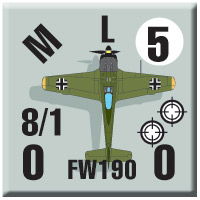
This radial engine Focke Wulf fighter was introduced in September
of 1941 and devastated the Spitfire V’s then in use.
The British aborted the new Spit VIII and had to re-design
the Mk V as the Spit IX in late 1942. The aircrafts main deficiency
was a loss of performance above 20,000 feet. The primary FW
was the A version which served from 41-45. The F and G versions
were fighter bombers and in 1944 the designer Kurt Tank when
thwarted in the production of the new Ta-152 took an A air
frame mated it to a Ju88 bomber engine and apologized that
this piece of junk was all he could offer. Amazingly the Fw-190D
proved to be an outstanding fighter at any altitude. The different
A versions carried an amazingly diverse armament from 7.92mm
Machine guns to 30mm cannon. In the invasion of Dieppe the
Fw-190 achieved a 4:1 kill ratio over the RAF.
He-219
Very advanced twin-engined night fighter privately built by
Heinkel. It caused much infighting in the Luftwaffe High Command
and few were built. Ground crews even assembled new aircraft
from spare parts to keep up with demand. It entered service
in 1943 and armament was 6 x 20mm and 2 x 30mm cannon. Most
versions had ejector seats installed, a new innovation.
Me-262
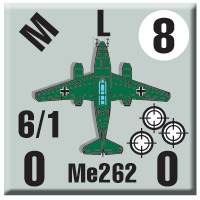
The world’s first operational jet fighter and the most
advanced jet of World War Two with superior characteristics
and better armament than the Meteor or Bell P-59 contemporaries
it entered combat in 1944. The plane was twin-engined with
4 x 30mm cannon and options for bombs. A two-seat radar equipped
night fighter was also produced. It benefited from the partially
swept wing design. The engines were the main problem as the
metallurgy was too brittle for the heat they generated.
The Bombers
Any Luftwaffe unit could be assigned a maritime strike. However
a number of units were formed purely for anti-shipping (A/S)
duties. KG 40 (Biscay) and KG 100 (Mediterranean), KGr 106,
206, 306, 406, 506, 606, 706, 806, 906; seven SAGr were sea
recon units, seven independent squadrons and a minesweeping
gruppe with converted Ju-52MS aircraft. KG 26 and 30 kept
units in Norway aimed at Murmansk convoys with Ju-88 and He-111,
SG 5 had Ju-87D and a Kirkenes-based unit had Ju-188E bombers.
An Fw-200 unit from KG 40 was in Norway along with a number
of independent squadrons usually with He-111, He-115 or Ju-88.
Torpedoes came from pre-war stocks and Italy prior to 1942
and captured Norwegian weapons which were the standard for
Germany. KG 26 was specially trained for low level bomb attacks
at sea and eventually received torpedoes. Most German medium
bombers were woefully under armed with four to six 7.92mm
machine guns the later war bombers carried improved defensive
armament but never on the American scale.
Ju-52
A three engined commercial airliner that was used as a bomber
in the Luftwaffe’s early days. After the introduction
of better bombers the Ju-52 "Tante Ju" spent the
war as Germany’s primary air transport. A minesweeper
Ju-52MS was used to detonate mines magnetically using a large
ring.
Ju-86
A twin-engined bomber that was just being phased out at the
start of WW2 was thereafter used for high altitude reconnaissance.
The engines were diesel powered and special Ju-86 were re-manufactured
for high altitude work during the war until 1943. It too was
originally built as an airliner.
Ju-87

One of the most famous planes of World War Two, the Junkers
dive bomber known as the Stuka began a reign of terror in
Spain when Guernica was bombed and was feared until the Battle
of Britain in 1940. Losses were severe and the aircraft was
withdrawn from France. It served in Norway and the Mediterranean
through 1943 and in Russia until early 1945. The aircraft's
main weakness was slow speed that made it an easy target for
enemy fighters. Used overwhelmingly in the ground war it was
capable of doing great damage against naval targets. Graf
Zeppelin’s Ju87 squadron fought in Poland in 1939 and
sank an enemy destroyer. The B model was available in 1939
with some long ranged R variants. The C model was for the
carriers while the 1942 D was an improved B. A special anti-tank
version the G was used in Russia from July 1943.
Ju-88

Introduced in December 1939, the fast Junkers bomber proved
adaptable to night fighter, medium bomber, dive bomber (rarely
used) and was used against enemy shipping particularly from
Norway and Mediterranean bases. Most were A series with C
and G being night fighter variants. In 1943 the Ju188 appeared
about 500 A and E versions were produced, most were bombers
and a few were torpedo planes.
Do-17Z
The radial engined Dornier began life as a fast mail plane
but was found suited for bomber duties. Production ended in
1940. Used primarily against ground targets the Do-17Z and
the fast inline engine variant Do-215 (originally meant for
export) were used against British Channel convoys in the opening
days of the Battle of Britain. Heavy losses caused transfer
east to Russia and the Mediterranean. The type was retired
from bomber duty in 1942. KGr.606 a Kiel-based Coastal unit
operated three squadrons of Do17Z from 11/39-12/41.
Do217
The replacement for the Do-17 proved to be a very capable
A/S aircraft it was used by KG 40 in France and KG 100 in
France and the Mediterranean Sea. It was the first missile-equipped
aircraft when the Hs-293 guided missile was introduced for
A/S attacks. A Do-217K sank the new battleship Roma with a
Fritz X when it attempted to join the Allies. The E version
was introduced in 1941 and the K version in late 1942. It
carried 6600 lb of bombs against the 2200 Do-17 or 4400 He-111/Ju88;
it also had a torpedo version.
He-111H

This former Heinkel airliner was Germany’s primary
bomber in 1939 and served throughout the war. Used in anti-shipping
role frequently it excelled as a torpedo bomber. In late 1942
the H-16 version was introduced with a 7000 lb payload but
needed Rocket Assisted Take-off (RATO).
He-115
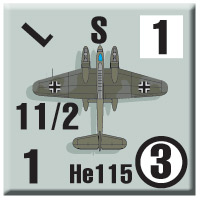
A large floatplane used in the invasion of Holland. Transferred
to Norway the plane gave excellent service in the A/S role
and had both bomber and torpedo capabilities.
He-177
A four-engine heavy bomber that had two propellers, was fast
and agile and used by KG 40 from French bases as a dedicated
A/S plane. The model was prone to fires from the twin engines
in one nacelle. A prototype He-277 with four propellers solved
the problem but few were built. The plane could carry 2200
lb of bombs and 2x Hs-293 missiles or Fritz X anti-warship
glide bombs.
Fw-200C
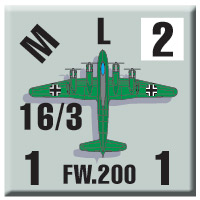
Another converted airliner this was Germany’s first
four-engine bomber. It was designed by Focke Wulf chief designer
Kurt Tank. It entered combat with KG 40 in April 1940 and
was initially based in Denmark. Rarely were more than 12 planes
operational and only KG 40 had combat versions. The plane
carried 2000 lb of bombs (4x 250 kg) until a new version in
1941 which carried 4600 lb of bombs (4x 500 kg plus 12x 50
kg bombs). A version was created allowing the carrying of
2 x Hs-293 missiles. Being an airliner the plane was very
fragile, many fell apart from landings and take-offs, fighters
found them easy prey even Sunderland flying boats could kill
them with ease. They were withdrawn from combat after their
Biscay bases were overrun in 1944.
Hs-123
A single-engine biplane dive bomber, it served little time
in that role being replaced by Ju87’s barely a year
after introduction. As dive bombers they were unsuccessful
carrying just four 110lb bombs and two Machine guns. However
they proved to be excellent close air support aircraft and
night intruders that could absorb tremendous damage. The crews
loved them and they served in Spain, Poland, France and finally
Russia through 1944.
Hs-129
This twin-engined heavily armored aircraft was designed as
a tank buster, a role at which it excelled though it was underpowered
with French-produced engines. It was so cramped inside some
instruments were mounted outside the cockpit. Armament varied
with 2 x 20mm cannon and either 2 x machine guns or 2 x 20mm
in addition. A 30mm, 37mm or 75mm cannon was carried in a
pod underneath the fuselage or 8 x 110lb bombs were carried
there. At Kursk a Hs 129 unit with Fw 190 escort wiped out
a Soviet tank brigade, the first time in history a ground
attack was stopped from the air alone.
Ar-196A
The twin float plane from Arado in 1937 was probably the best
single-engined plane of its type in service in World War Two.
Armed with 2 x 20mm and one machine gun forward and another
machine gun facing rearward, the plane could even intercept
bombers. The aircraft was used aboard German ships and from
seaplane bases they were used for recon and anti-submarine
duty. On May 5, 1940 Ar-196’s captured sub HMS Seal
that surfaced to surrender after 29 hours of bombing.
Bv-138
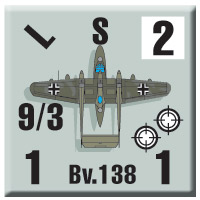
The Luftwaffe’s primary long range naval recon plane
entered service in 1939. The plane was heavily armed with
two 20mm and one 13mm cannon plus an optional machine gun
and could absorb heavy damage. British Sunderland and Hudson
bombers that approached Bv-138’s usually lost an aerial
duel. The early version carried three 110 lb bombs or two
depth charges, later versions increased to six or four respectively.
Fl-282
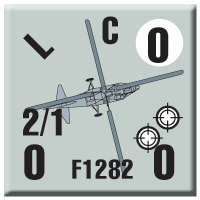
A successful helicopter design by Anton Flettner the Fl-282
was his third prototype to be introduced. The earlier Fl-265
and Fl-184 were both destroyed before testing. The Fl-282
was tested in1941 and 20 of the 24 prototypes were entered
into combat in 1942 as fleet recon escorts and ASW bombers.
In early operations the 'copter was found to have all-weather
capability and 1000 more were ordered. The factory was destroyed
in an Allied bomb raid so production never started. Only Storm
or Gale weather conditions should ground the copter.
Take these aircraft into action!
Click here to order Sea of Iron right now!
|
